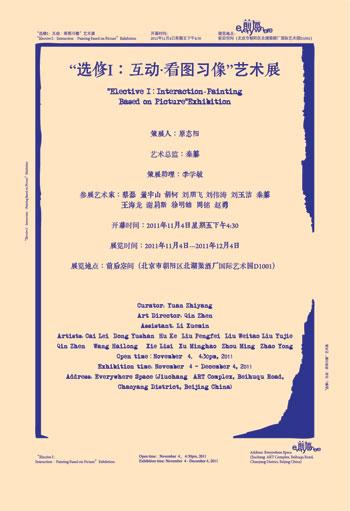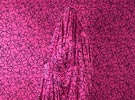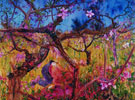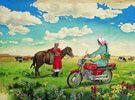
展览时间:2011-11-04 ~ 2011-12-04
展览地点:前后空间
艺术总监:秦蓁
策 展 人:原志阳
助理策展:李学敏
参展艺术家:蔡磊、董宇山、胡柯、刘朋飞、刘伟涛、刘玉洁、秦蓁、王海龙、谢莉斯、徐明皓、周铭、赵勇
开幕时间:2011-11-04 16:30
展览介绍:
“选修”是我们在学校、社会以及日常生活中较为耳熟的一个词,其常规性语义通常被描述为“人物主体依据自己的行为能力与兴趣喜好对客体对象进行的一种自由性择取与习修”,它最终的结果是“有或无”。
之所以将本次展览定为“选修”,也是出于对当代艺术和大众的共生关系的考虑。如若将当代艺术与社会大众作为“选修”的一个释意范畴,在两者间进行一种常规性的“选修”描述的话,我们通常会认为前者是后者的一个选修对象,而不会生成一种反观性的想法。实际上,就当代艺术而言,讲求“互动”与观众的有效参与一直是它力所倡导的,同时这也是表现它贴近于社会和生活的一面。当然,它的这种互动性可以表现在行为艺术、装置艺术以及新媒介等艺术子门类上,但如何在当代绘画和雕塑媒介上进行一种互动方式的探索,如何让观者有效的选修和参与到绘画、雕塑艺术的生成过程中去却是是有待探索的。这种探索对于艺术家来说,更多的可能是在形式、内容以及绘画语言通道的探索。对于展览策划者来说,可能是一种展览组合方式的探索,即“什么是一次较为完整的展览?”。对于社会大众来讲,他们是人们生活世界的主角和创造者,是艺术土壤的制造者,亦是艺术的参与者。三者间相互联系,是一个有机的整体,缺一不可。
与所有的艺术种类一样,当代艺术也本着“艺术源于生活又高于生活”的创作理念。源于生活表现在它以日常生活、当代社会为创作土壤,高于生活表现在它作品的呈现内容、方式以及思想上。
相对于本次展览而言,以当代艺术和观者的互动性为大背景,以自由择取的方式展开,在此基础上进行一次“看图习像”的场景化叙述和观看人群的实践性体验是此次展览力求的。这种力求性体现在将艺术家所造之像(形)与观众所造之像(包括身体语言、情绪表达、文字语言、图像语言等)置于同一时间和同一空间中,去促成一次“选修”,从而去触发一种显性图像与隐性图像间的呼应关系,去挖掘图像背后对现今人类自身以及人类生存空间的关注和关怀。
就此次的参展的十一位青年艺术家来讲,他们均毕业于国内专业的美术学院,作品表现上有着不同的地域特色和相同的人文性关怀。他们采用着新型的视觉图像对这一主题进行着微观的叙述和表达。细观作品,我们可以将参展的作品大致分为三类:一、对当代社会中人的状态的关注,包括童年记忆、青春叙事、伤痕表达;二、对当下人们精神丢失和生命体的关注;三、对现代社会城市生活环境,即人类生存空间的关注。
类型一在图像主题表述上以刘玉洁、胡柯、刘朋飞、刘伟涛、秦蓁的作品为代表。对复杂空间的营造一直是刘玉洁绘画中所体现的,这种营造在图像上表现出一种梦幻与想象,甚者表现出更多童事的印迹。对于她而言,绘画不在是一种图示,而是一种游离着的思绪。与之相似的是胡柯,他的雕塑充满了青春的想象。在胡柯的作品中,这种想象既是崇高的,同时又是玩笑和嬉戏化的。正如他的《孤峰》那样,登山眺望进行着崇高化的膜拜和胸中之气的写就,回到《红色密室》又会让他的胸气进入一种自恋式的冥想之中,这是一种处于青春阶段的我们所经历的矛盾,一种狂热的理想孤独与生理上的热血冲动。而刘朋飞的类似于老式胶片机的成像方法,颗粒状和底片似的色调绘制,更是以一种偶然性的效果较为精准的捕获了当代年轻人的渺茫、失落等情绪化的生活状态。与之不同的刘伟涛,他将杂草与藏匿起来的小人所构筑成自己的《伤痕日记》。巨大的针状植被将小人予以包围起来,他四周都存在着潜在的伤害,无法逃出,这似乎是梦境又似处境,一种无耐性的状态被他描绘在纸面之上。秦蓁的作品有着丰富的色彩关系,纯厚的背景色和鲜亮的前景色,两者间相互比对而又不乏统一,作为一名花季时期的女性艺术家,对花儿的绘画题材的关注是她一直在进行的,这同时也是源自她对自身角色的思考和现阶段的体验性表述。
类型二的图像主题表达以蔡磊和赵勇的作品为代表。“当神性的雕像倒塌,当人们心中的英雄逝去,当风景已不再成为风景……”,此时,我们或许发现了我们该去找寻的丢失,而赵勇的作品正是为人们打开了一条找寻的道路,一条通往找寻丢失精神的道路。与赵勇的绘画手段描述不同,蔡磊将具有实验意义的综合材料运用于他的雕塑作品中,来展开他对人类生命过程的询问和探索。同时,材料的恰当使用,使得他的作品更具有生命体特征,更具真实性。“白色的头发,枯萎的树叶,紧闭的双眼,这一切好似讲述着一个生命体的结束,但安详的面容,年轻的身体、稚嫩的面孔似乎又演示着生命体的重生”。
类型三在图像主题表述上表现为间接性揭示和直接性批判两种,前者以王海龙和谢莉斯为主,后者以徐明皓、周铭和董宇山为主。王海龙和谢莉斯视乎是两个挖掘者,在他们的作品中,我们看到的是一双揭露的双眼和一种不确定性的图像结果表现。王海龙的作品反对语意的介入与文字的阐释,他更多的希望观众通过图像去进行自身的不确定性推断。而谢莉斯则从绘画媒介对新型电子媒体所示图象的角度给与挖掘,她用传统的绘画媒介对现代社会中的电视、电子摄像等媒介图像进行一种拼图化的并置展现,在她的作品中我们往往可以看到多个荧幕图像的并置,且图像间又没有具体的表面逻辑关系,而每个图像背后却隐藏着一个共性关系,即向我们叙述着现时性中被我们习惯性了的事物其背后的隐藏。与他们两位所不同的是徐明皓和周铭对社会的直接性批判.“信仰的回归、神性的呼唤”,是徐明皓近阶段的作品中一直在图说的。科技的发展和应用促使了现代社会的飞跃发展。耸立的高楼,自动化的交通,丰富的物质,这是科技闪亮的地方,却也是科技可以逐步替代上帝的“掩体”。科技时代的危害性直接的表现在,它强大的杀害性战争、环境的重度污染等直接性的方面以及道德的丢失和人性的功利化趋势此类它“魔鬼性”驱使的一面。同时,这种对现代社会的批判性亦表现周铭的城市小区风景中,对城市化和人造风景的异质性观点,是在他近作中所强调的,人造风景对自然风景的破坏和人造性的单一化模式是艺术家不愿意看到的。在董宇山的作品中,无论是《无源之水》还是《现场》都可以让你寻觅出一种强大的力量,它视乎要将眼前的事物给你彻底的摧毁。灾难来临,树木是黑色的,水源也是黑色的,土黄的大地是干裂的,画面之中,除去弱小的白色生命,其余之物在顷刻间都将沦入黑色死神的“口中”。
综上所述,本次展览如何让“选修”成为一次互动,成为一次看图习像性的真实参与,这是值得我们共同期待的。
原志阳 写于北京寓所
2011.9.18
"Elective" is a common-use word in the school, society and in daily life. In the conventional context, it is described as “Permitting a free choice on what to learn, based on one’s ability and interest ". The result is "do or not to do".
We name this exhibition “Elective "due to our consideration of the symbiotic relationship between contemporary art and the public. When we comprehend contemporary art and the public in the conventional context, we will reach a conclusion that contemporary art is an elective course taken by the public, instead of regarding the public as a course. In fact, contemporary art is committed in advocating the interaction with the public, which shows its friendliness to the society at the same time. This kind of interaction is expressed well in action art, installation art, new media, etc. However, there are some other questions waiting for our answers. How to explore an interactive mode in contemporary painting and sculpture? How to have the public participate in the process of creation? Artists still need to improve in some aspects such as the form, the content and the painting language.
The same as other art types, contemporary art is also base on the concept "Art comes from life and stands higher than life”. Art absorbs nutrients from the society and expresses in another way through its content and mode. Speaking of the exhibition, the interaction between contemporary art and viewers is its background. Besides, the exhibition strives to establish the link between the practical experience of viewers and the artistic narrative of the exhibition. We call this kind of link “Elective” because at the same time and space, patterns created by artists and thoughts generated by audience (including body language, emotional expression, the image, etc) collide. In this way we call on the care for mankind’s living space and mankind itself.
Concerning the eleven young artists appeared in this exhibition, we are proud to introduce that they all graduated from domestic professional art academy. Their works show us different features but the same humanism philosophy. They all illustrate their themes from a microcosmic standpoint. We try to divide their works into three categories: First, attention to people’s living conditions, including recalling childhood life, narrating pains in life course. Second, expressing the feeling of lost. Third, paying attention to our living environment.
In the first category, works of Liu Yujie, Hu Ke, Liu Pengfei, Liu Weitao, Qin Zhen are representative ones. In Liu YuJie’s painting, the complex background gives us a dreamlike image which is mostly the recalling of her childhood. For her, painting is not a kind of image, but a free thought. Similarly, Hu Ke connects his imagination of youth with his sculptures. In Hu Ke’s works, this kind of imagination is noble, but sometimes chaffing. In his work "Isolate Peak", overlooking on a hilltop leads to the sense of lofty. However, in "The Red Chamber", he plunges into a narcissistic type of meditation. Just like our youth, his youth is full of loneliness and passionate physical impulsion. Liu Pengfei adopts an imaging method of old-style film camera. His works accurately catch the emotion of young people such as the feeling of uncertain and lost. Liu Weitao’s work is quite different. He posits roles like weeds and Lilliput in his “The Scars Diary”. Huge needle vegetation surrounds him and he is able to do nothing with the potential damage. It seems his feeling of helplessness is expressed on the paper totally. Qin Zhen’s works have abundant colors. Pure thick background color and bright forecolor, both mutual contrast and no lack of unifying. As an adolescent female artist, she all the way has been interested in the flowers painting theme. This is from thinking her own role and experiential expression at this stage.
In the second category, works of Cai Lei and Zhao Yong are representative. "When the statue of God collapses, when the hero dies, when scenery is no longer beautiful......” When all this happens, we should find our lost things. Zhao Yong’s painting is precisely the path to look for the lost. Different from the description of Zhao Yong’s, Cai Lei uses some materials in his sculpture which are practically meaningful. His proper use of materials makes his works more vivid and lifelike. "White hair, withered leaves and closed eyes are all inferring the end of life, however, the serene face, young body and childish face are predicting the birth of life."
In the third category, there are two different styles which are indirect revealing and direct criticizing. The representatives of the former are Wang Hailong and Xie Lisi, and Xu Minghao, Zhou Ming and Dong Yushan are of the latter. Wang Hailong and Xie Lisi are like two diggers. In their works, we can read they keep exploring with their eyes and expressing with some uncertain images. Wang Hailong seldom uses word to explain directly. Instead, he hopes views think by themselves which will lead to more uncertainty. Xie Lisi tries to show the images of TV and electronic camera which are new media in modern society in a traditional painting method of collage. In her works, arrangement of images is not logical outwardly, however, as a matter of fact different images have a common feature. Xu Minghao and Zhou Ming are different from the two artists mentioned above. "The return of the belief, the call for the divinity" is what Xu Minghao shows in his works. The development and application of science and technology prompt the rapid increase of modern society. Huge buildings and automatic traffic become the shining point of technology, but they are the "bunker" which replaces the god in fact. The destructive effects of technological generation come through wars, environmental pollution and the loss of morality and human nature. This kind of direct criticism can be seen in Zhou Ming’s work also. The negative viewpoint to urbanization and man-made landscape is the emphasis in his recent works. Artists are not willing to see natural scenery damaged by man-made landscapes. In Dong Yushan’s works, whether in the " Baseless " or "Live", can you find out a kind of great power, which seems to completely destroy the world you see. Disaster coming on, the trees are black, the water is black, the yellow earth is dry and parched. In the picture, except for the white weak living thing, all these will instantly fall into the "mouth" of the black Azrael.
To sum up, in this exhibition, how to make "Elective" a real interaction and participation based on “Learning through Watching” is worth our waiting.
Yuan Zhiyang
Writing in Beijing
2011.9.18
- 2011-09-18 ~ 2011-10-07分裂+聚合:兰一新作展
- 2011-09-25 ~ 2011-11-20自语——夏小万个展
- 2011-09-06 ~ 2011-10-16镜之城:金阳平个展
- 2011-09-10 ~ 2011-10-23赵赵:近作
- 2011-09-10 ~ 2011-11-10桃源记——杨泳梁个人摄影展
- 2011-10-28 ~ 2011-11-1815日:合作制绘画
- 2011-11-04 ~ 2011-12-04“选修I:互动·看图习像”艺术展
- 2011-10-22 ~ 2011-11-05心境——王五龙摄影展
- 2011-10-22 ~ 2011-10-31壹精扒褂——潘聪绘画作品展
- 2011-10-29 ~ 2011-11-30信仰与思维——文本意义下的形意表达










